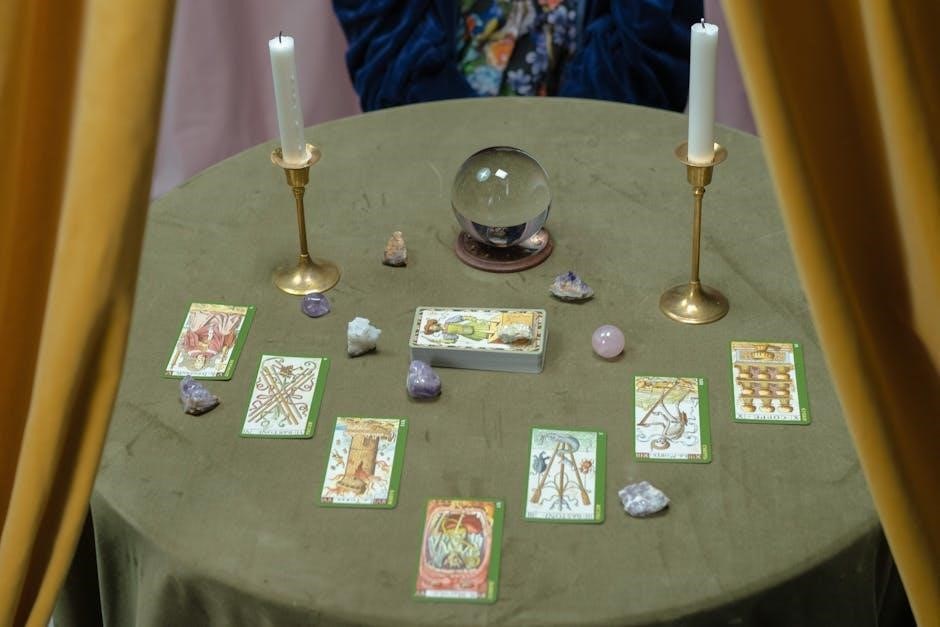Cartomancy is a divination practice using standard playing cards to uncover insights into the past, present, and future․ It combines intuition with card meanings for self-discovery and guidance․
1․1 What is Cartomancy?
Cartomancy is a form of divination that uses playing cards or tarot cards to gain insight into the past, present, or future․ It involves interpreting the symbolism, imagery, and numerical values of the cards to uncover hidden meanings and guidance․ Unlike tarot, which often focuses on deeper spiritual themes, cartomancy typically uses a standard deck of playing cards, making it more accessible to beginners․ The practice combines intuition, tradition, and psychological insight to provide answers to questions, offer advice, or reveal potential outcomes․ Cartomancy is a versatile tool for self-reflection, decision-making, and understanding life’s challenges and opportunities․
1․2 Brief Overview of Cartomancy
Cartomancy is a divination practice that uses cards to uncover hidden truths, guide decision-making, and explore future possibilities․ It blends intuition, symbolism, and tradition to provide meaningful insights․ Unlike tarot, cartomancy often uses a standard playing deck, making it accessible to everyone․ The practice involves interpreting card meanings, suits, and combinations to address various aspects of life․ Whether for personal reflection or seeking clarity, cartomancy offers a versatile tool for gaining perspective․ Its simplicity and depth make it a popular choice for both beginners and experienced practitioners, allowing individuals to tap into their intuition and navigate life’s challenges with confidence and awareness․

History of Cartomancy
Cartomancy has ancient origins, evolving from early divination practices․ It developed alongside playing cards in Europe, influenced by various cultures, and remains still popular today․
2․1 Origins of Cartomancy
Cartomancy traces its origins to ancient China, where playing cards were first invented during the Tang Dynasty (618–907 CE)․ These early cards were used for gaming, but their use for divination emerged later․ The practice spread to the Middle East and Europe through trade routes, evolving over centuries․ By the 18th century, cartomancy gained prominence in France, where it became a popular form of fortune-telling․ The tarot deck, originally a gaming tool, was adapted for divination, blending symbolism and intuition․ Over time, cartomancy incorporated elements from various cultures, shaping it into the diverse practice seen today․
2․2 Evolution of Cartomancy
Cartomancy evolved significantly as playing cards spread from China to Europe in the 14th century․ Initially used for games, cards gradually incorporated symbolic meanings, especially in France during the 18th century․ The tarot deck, originally a gaming tool, became central to cartomancy, blending esoteric symbolism with intuitive readings․ By the 19th century, cartomancy gained popularity, with systems like Lenormand cards emerging․ The 20th century saw the rise of modern tarot decks and interpretive guides․ Today, cartomancy is practiced worldwide, with diverse styles and digital tools enhancing its accessibility․ Its evolution reflects cultural adaptation, making it a dynamic and inclusive form of divination․

Types of Cartomancy
Cartomancy encompasses various traditions, including traditional European methods using standard playing cards and Lenormand cartomancy with its unique symbolic deck․ Each style offers distinct interpretations and techniques․
3․1 Traditional European Cartomancy
Traditional European cartomancy is one of the most widely practiced forms, often using a standard 52-card deck without jokers․ This method relies on interpreting the suits, numbers, and court cards, with each holding specific meanings tied to everyday life․ Hearts symbolize emotions, diamonds represent finances, clubs reflect friendships, and spades signify challenges․ The deck is deeply rooted in European folklore, with interpretations passed down through generations․ Readers often combine intuition with symbolic associations, making it a versatile and accessible form of divination․ This traditional approach emphasizes practical guidance, focusing on tangible outcomes and personal decisions, making it a popular choice for those seeking clarity in daily matters․
3․2 Lenormand Cartomancy
Lenormand cartomancy is a distinct form of divination named after Madame Lenormand, a renowned French fortune-teller․ It uses a specific 36-card deck, each featuring unique symbols like animals, objects, and scenes․ Unlike traditional cartomancy, Lenormand readings focus on the interaction between cards, offering detailed and practical insights․ The system emphasizes combinations, with each card influencing the interpretation of others․ Lenormand cartomancy is often used for specific questions, providing clear and actionable guidance․ Its structured approach, with predefined spreads, makes it accessible yet powerful․ Originating in the 18th and 19th centuries, this method remains popular for its precision and ability to address everyday concerns effectively, blending tradition with intuitive insights․

How to Get Started with Cartomancy
Begin by understanding the basics of cartomancy, including card meanings and simple spreads․ Start with a clear intention, shuffle the deck, and focus on your question․
4․1 Choosing the Right Deck
Selecting the right deck is crucial for cartomancy․ Traditional playing cards or Lenormand decks are popular choices, each offering unique symbolism․ Consider the deck’s imagery, as it should resonate with your personal energy․ Some decks feature intricate designs, while others are simpler․ If you’re a beginner, opt for a standard 52-card deck, as it’s widely used and easier to learn․ Ensure the cards feel comfortable in your hands and the size is manageable for shuffling․ Trust your intuition when choosing—pick a deck that feels right to you․ A clear guidebook is also essential for understanding card meanings and interpretations․
4․2 Preparing the Deck
Preparing your cartomancy deck ensures it is cleansed of negative energy and aligned with your intentions․ Begin by shuffling the cards thoroughly, which helps mix their energies and creates a connection between you and the deck․ Some practitioners also perform rituals like smudging with sage or palo santo to purify the cards․ Additionally, placing the deck on a crystal or under a moonlit window can enhance its energy․ Finally, set a clear intention for the deck, such as using it for honest guidance or positive outcomes․ This preparation step is essential for accurate and meaningful readings, fostering trust and clarity in your practice․

Understanding Card Meanings
Understanding card meanings is fundamental for effective cartomancy readings․ Each card carries unique symbolism, reflecting emotions, events, and energies, guiding you to interpret their messages accurately․
5;1 Suit Meanings in Cartomancy
In cartomancy, each suit holds distinct meanings, reflecting different aspects of life․ Hearts symbolize emotions, love, and relationships, while Diamonds represent financial matters, material possessions, and practicality․ Clubs, often linked to creativity, inspiration, and community, signify new opportunities and collaboration․ Spades, associated with challenges, decisions, and mental clarity, often represent conflict or transformation․ Understanding these suit meanings provides a foundation for interpreting cards in a reading, allowing you to connect their themes to real-life situations․ By recognizing the symbolism of each suit, you can better decipher the messages the cards convey, whether they relate to emotional, material, social, or mental realms․
5․2 Number and Face Card Meanings
In cartomancy, number cards and face cards carry unique meanings that enhance interpretations․ Number cards often symbolize specific numerical values or concepts, such as progress (3), stability (4), or change (5)․ Face cards, including Jack, Queen, King, and sometimes Joker, represent people or archetypes in a reading․ For example, the Jack may signify a young person or messenger, while the Queen embodies nurturing energy and the King represents authority or leadership․ These cards can also reflect aspects of the querent’s personality or external influences․ Understanding their individual meanings and how they interact within a spread deepens the insight and accuracy of a cartomancy reading․
5․3 Interpretation of Card Combinations
Interpreting card combinations is a cornerstone of cartomancy, as the interaction between cards reveals deeper insights․ The position of each card in a spread influences its meaning, and combining their interpretations provides a nuanced understanding․ For example, a heart suit paired with a ring card may signify a romantic commitment, while a spade combined with an ace could indicate new challenges․ Contradictions in combinations, such as a positive and negative card together, often suggest balance or choices to be made․ Practitioners must consider the context, themes, and subtle connections between cards to craft a cohesive narrative․ This skill enhances accuracy and enriches the reading experience․

Card Spreads in Cartomancy
Card spreads are structured layouts used to explore specific questions or situations․ Each spread offers unique insights, guiding the interpretation of card meanings and their connections․
6․1 Basic Spreads for Beginners
Basic spreads in cartomancy are simple layouts designed for individuals new to the practice․ These spreads help beginners understand the fundamentals of card interpretation and how to connect meanings․ The One-Card Spread is the simplest, offering a straightforward answer to a specific question․ The Three-Card Spread represents past, present, and future, providing insights into a situation’s progression․ Another popular option is the Celtic Cross Spread, which, despite its complexity, is often taught to newcomers as it covers various aspects of a question․ These spreads are excellent for building confidence and developing interpretative skills before moving to more advanced layouts․
6․2 Advanced Spreads for Detailed Readings
Advanced spreads in cartomancy offer deeper insights and complex interpretations, ideal for experienced practitioners․ The Tree of Life Spread examines various life aspects, while the Astrological Spread aligns cards with zodiac positions for comprehensive analysis․ The Relationship Spread explores dynamics between individuals, and the Year Ahead Spread provides a 12-month forecast․ These layouts require a strong understanding of card meanings and intuitive connections․ Advanced spreads are perfect for those seeking detailed guidance and are willing to invest time in deciphering intricate patterns․ Mastery of these spreads enhances interpretative skills and deepens the connection with cartomancy․

Reversals in Cartomancy
Reversals in cartomancy indicate blocked, delayed, or opposite energies of a card’s upright meaning, offering a fresh perspective for deeper, nuanced interpretations in readings․
7․1 Understanding Reversed Cards
Reversed cards in cartomancy signify a blockage, delay, or the opposite of the upright meaning․ They can indicate challenges, unconscious patterns, or external circumstances affecting a situation․ Reversals offer a deeper layer of insight, revealing what may be hindering progress or influencing decisions․ They don’t always mean the opposite but rather a shift in perspective or energy․ For example, a reversed card might suggest unexpressed emotions, delayed opportunities, or a need to reevaluate․ The position of the card in a spread and the question being asked help determine its specific interpretation․ Reversals encourage the reader to explore hidden dynamics and potential obstacles․ They add complexity to readings, making them more nuanced and personalized․
7․2 Interpreting Reversed Meanings
Interpreting reversed meanings in cartomancy requires context and intuition․ A reversed card can indicate the opposite of its upright meaning, a delay, or a blockage․ It may suggest unconscious patterns, hidden influences, or unresolved issues․ For example, a reversed Lovers card might signify miscommunication or delayed decisions in a relationship; The position of the card in the spread and the question asked are crucial for accurate interpretation․ Reversals can also highlight areas where growth is needed or where energy is stagnating․ By considering the surrounding cards and the querent’s situation, readers can uncover deeper insights and offer guidance tailored to the circumstances․ Practice and intuition refine the ability to interpret reversed meanings effectively․

Conducting a Reading
Conducting a reading involves creating a calm environment, clarifying intentions, and shuffling the deck․ The reader draws cards, interprets their meanings, and provides insights to the querent․
8․1 Setting Intentions and Grounding
Setting intentions and grounding are essential steps before a reading․ Begin by clarifying the purpose of the reading, whether for self-reflection or guidance for others․ Create a calm and centered atmosphere by grounding yourself through deep breathing, visualization, or a brief meditation․ This helps connect with your intuition and ensures clarity․ You can also smudge the space with sage or light a candle to purify the energy․ Clearly define the scope of the reading to focus the cards’ messages․ This intentional preparation enhances the accuracy and relevance of the insights, allowing for a more meaningful and aligned interpretation of the cards․
8․2 Shuffling and Cutting the Deck
Shuffling and cutting the deck are crucial steps in preparing for a reading․ Begin by shuffling the cards with intention, using a method that feels natural to you, such as an overhand, riffle, or hindu shuffle․ This process mixes the cards and infuses them with your energy․ Once satisfied with the shuffle, offer the deck to the querent or cut it yourself, typically with the left hand, to finalize the mix․ Cutting the deck breaks the predetermined order, ensuring the reading is tailored to the moment․ This step symbolizes collaboration between the reader and the cards, creating a personalized and meaningful connection for the reading ahead․
8․3 Drawing and Interpreting Cards
Once the deck is shuffled and cut, it’s time to draw the cards․ The number of cards drawn depends on the spread being used, but focus on the top cards, as they represent the current energy․ Lay them out in the predetermined pattern, ensuring each position aligns with its meaning․ When interpreting, consider the card’s traditional meaning, its position in the spread, and any intuitive feelings․ Reversed cards may indicate blocked or opposing energies, so trust your intuition when deciding their significance․ Connect the cards’ stories to form a cohesive narrative, linking their symbolism to the querent’s situation․ Documenting your insights helps refine your skills and provides clarity for the reading’s outcome․

Journaling Your Readings
Journaling your readings helps track progress, reflect on past interpretations, and refine your skills over time, serving as a valuable record of your growth in cartomancy․
9․1 Importance of Keeping a Journal
Keeping a journal is essential for tracking your progress, reflecting on past readings, and refining your cartomancy skills․ It allows you to document each session, noting the cards drawn, their interpretations, and the outcomes․ Over time, this record helps identify patterns, recurring themes, and areas for improvement․ Journaling also enhances intuition by encouraging you to think critically about your readings․ By revisiting past entries, you can gain insights into how your interpretations have evolved and refine your understanding of the cards․ This practice fosters accountability, deepens your connection to cartomancy, and serves as a valuable resource for future readings and personal growth․
9․2 How to Document Your Readings
Documenting your readings involves systematically recording details to preserve insights and track progress․ Start by noting the date, time, and the question or focus of the reading․ List each card drawn, including its position in the spread and your immediate impressions․ Write down your interpretation of the cards, both individually and how they relate to each other․ Include any intuitive flashes or emotions that arise during the reading․ Reflect on the accuracy of the reading over time and note any patterns or themes․ Consider adding a photo of the spread for visual reference․ Store your journal in a safe place and revisit it periodically to gain deeper insights and refine your practice․
Tips for Beginners
Start with simple spreads and gradually explore complex techniques․ Trust your intuition and practice regularly to build confidence․ Keep sessions focused to avoid confusion․
10․1 Starting Small with Simple Spreads
Beginners should focus on simple spreads to ease into cartomancy․ Start with a one-card draw for daily insights or a three-card spread for past, present, and future․ These basic layouts help build confidence and clarify interpretations․ Avoid complex spreads initially, as they can overwhelm․ Practice with straightforward questions and trust your intuition․ Over time, as you gain experience, you can explore more intricate spreads․ Consistency is key—regular practice strengthens your connection with the cards․ Keep your intentions clear and focus on one question at a time․ Simple spreads are foundational and will help you develop the skills needed for deeper, more advanced readings․
10․2 Trusting Intuition and Interpretations
Trusting your intuition is crucial in cartomancy, as it bridges logic and inner wisdom․ While book meanings provide a foundation, your personal connection to the cards enhances accuracy․ Pay attention to first impressions and gut feelings during readings․ Intuition often reveals hidden patterns and deeper truths․ Practice regularly to strengthen this skill, and trust that your interpretations are valid, even if they seem unconventional․ Over time, you’ll develop a unique voice in your readings, blending traditional meanings with personal insights․ Patience and self-trust are key—your intuition will grow as you honor it․ Embrace this inner guidance to unlock the full potential of cartomancy․
Advanced Techniques in Cartomancy
Mastering advanced techniques enhances your cartomancy practice, offering deeper insights and precision․ Explore complex spreads, energy alignment, and intuitive connections to refine your readings and interpretations․
11․1 Using Intuition in Readings
Intuition plays a vital role in cartomancy, allowing practitioners to connect deeply with the cards and uncover hidden meanings․ Trusting your gut feelings enhances accuracy and personalizes interpretations․ Over time, intuition sharpens with practice, helping you sense subtle energies and themes in readings․ When a card resonates strongly, it often signifies relevance to the querent’s situation․ Pay attention to first impressions and unexpected thoughts during a reading, as they may hold significant insights․ Cultivating a meditative state before readings can heighten intuition, ensuring a clearer connection to the deck and the query․ Remember, intuition is a powerful tool that complements card meanings, making readings more profound and meaningful․
11․2 Combining Cartomancy with Other Practices
Combining cartomancy with other spiritual practices can deepen insights and enhance readings․ For example, pairing cartomancy with astrology allows for a cosmic perspective, while integrating it with meditation fosters a clearer connection to the cards․ Tarot and runes can also be blended with cartomancy to layer meanings and offer a more holistic understanding․ Additionally, using crystals or essential oils during readings can amplify intuitive abilities and create a sacred atmosphere․ Experimenting with these combinations encourages creativity and personalizes your practice, making readings more meaningful and aligned with your unique energy․ This synergy of practices often leads to richer, more nuanced interpretations․

Resources for Further Learning
Explore books, online courses, and communities to deepen your cartomancy knowledge․ Discover expert guides, tutorials, and forums for continuous growth and mastery of the practice․
12․1 Recommended Books on Cartomancy
Several books are highly recommended for deepening your understanding of cartomancy․ “The Tarot Bible” by Sarah Bartlett offers a comprehensive guide to tarot and its connections to cartomancy․ “The Cartomancy Bible” by Sarah Bartlett is another excellent resource, focusing specifically on playing card divination․ “The Oracle’s Handbook” by Anna Cordova provides practical techniques for readings․ “Reading the Cards” by Mary K․ Greer explores symbolism and interpretations․ These books cater to both beginners and advanced practitioners, offering insights into card meanings, spreads, and intuitive practices․ They are available on online marketplaces, metaphysical stores, and libraries, making them accessible for further learning and growth in cartomancy․
12․2 Online Guides and Communities
Online resources are invaluable for learning and mastering cartomancy․ Websites like BiddyTarot and Cartomancy․net offer comprehensive guides, tutorials, and interpretations․ YouTube channels such as Cartomancy with [Name] provide video tutorials and readings․ Social media platforms like Instagram and Facebook host active communities where practitioners share tips and experiences․ Forums like Reddit’s r/Cartomancy allow for discussions and Q&A sessions․ Additionally, online courses on platforms like Udemy and Teachable offer structured learning paths․ These digital resources help beginners and advanced practitioners alike to refine their skills and stay connected with the cartomancy community, ensuring continuous growth and learning in this ancient practice․
Cartomancy is a powerful tool for self-discovery and insight; This guide has provided foundational knowledge, encouraging you to embrace intuition and explore its endless possibilities․
13․1 Final Thoughts on Cartomancy
Cartomancy is a timeless practice offering insights into life’s complexities․ By mastering intuition and symbolism, one can unlock its full potential․ Whether for self-discovery or guidance, cartomancy adapts to individual needs, fostering personal growth․ Embrace its versatility, explore various techniques, and allow the cards to illuminate your path․ Remember, cartomancy is not just about predicting the future but understanding the present․ Trust your journey, and let the cards guide you toward clarity and wisdom․ With patience and practice, you’ll deepen your connection to this ancient art, discovering its transformative power in your life․
13․2 Encouragement to Continue Learning
Embrace the journey of cartomancy with curiosity and enthusiasm․ Continuous learning enriches your practice, revealing new depths in card meanings and techniques․ Each reading is an opportunity to refine your intuition and deepen your connection to the craft․ Don’t hesitate to explore advanced methods or seek inspiration from diverse traditions․ Remember, mastery grows with patience and dedication․ Celebrate small victories, and trust that your skills will evolve over time․ The world of cartomancy is vast and transformative—stay open to its wisdom and allow it to guide you toward personal and spiritual growth․ Keep exploring, and let the cards continue to inspire you․



